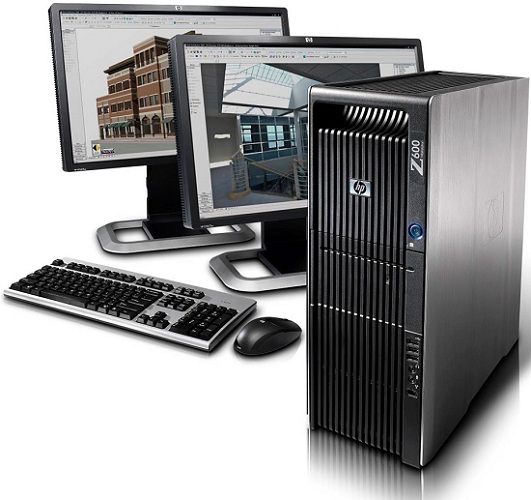In a bid to offer the right solutions for different classes of desktop personal computers, Intel Corp. recently presented its vision of desktop platforms to makers of PC components. Apparently, the world’s largest maker of microprocessors sees as many as six distinctive segments of today’s desktop market.
Sales of personal computers have been declining for a number of quarters already due to various reasons. As a result, in order to maximize sales of PCs, microprocessors and other devices, manufacturers need to offer tailored solutions that bring maximum value to the end-user. Intel believes that there are six segments of the desktop market that it needs to address with its current and upcoming microprocessors, reports DigiTimes.
- Enthusiast – PCs powered by Intel Core i7 processors and used for gaming, audio/video content creation and other tasks that require a lot of compute performance.
- Mainstream – PCs based on Core i5 and Core i3 processors that offer great price-performance ratios.
- All-in-one (AIO) – Systems featuring various energy-efficient processors and rich multimedia capabilities.
- Mini PCs or NUCs [next unit of compute] – Small form-factor computers with low-power Atom, Celeron, Core or Pentium microprocessors. Such computers can be used for various purposes and can run Microsoft Windows 10 or Google Chrome operating systems.
- Desktop replacement notebooks (portable AIO PCs) – High-performance personal computers in clamshell form-factors that are based on Core i7 or Core i5 microprocessors with 47W – 57W thermal design power.
- Compute sticks – Ultra small form-factor personal computers based on highly-integrated ultra-low-voltage system-on-chips. Such devices may also use both Microsoft Windows 10 and Google Chrome operating systems
Intel already offers a broad portfolio of processors, core-logic sets and solid-state storage devices for each type of desktops. However, going forward the chip giant might decide to offer certain bundles in a bid to decrease prices of systems while ensuring its own sales.
It is interesting to note that Intel reportedly considers segments of advanced desktops, NUCs and compute sticks as the most promising in terms of growth.
Intel did not comment on the news-story.
Discuss on our Facebook page, HERE.
KitGuru Says: Apparently, customers prefer either high-performance or miniature desktop PCs, meanwhile other segments are stagnating or declining. In fact, a rather surprising trend.
 KitGuru KitGuru.net – Tech News | Hardware News | Hardware Reviews | IOS | Mobile | Gaming | Graphics Cards
KitGuru KitGuru.net – Tech News | Hardware News | Hardware Reviews | IOS | Mobile | Gaming | Graphics Cards




If the CPUs are still integrated and limited to 47W, then calling them desktop replacement PCs are pointless.
Source: user of desktop replacement PC
I think what they are correct in a sense that the desktop is Intel G or i3 series and of course it is replaced by i7-HQ or if you stretch a little i5 (Not the U series) but their classification is wrong when they attached High Performance.
Well, it is Intel, nothing new with their marketing scheme.
Well, even a mobile HQ chip would slap the pants off of any locked desktop i5 unless it overdraws its TDP limit… but the point is that the MQ and QM chips didn’t have to be TDP locked. So it’s a flat downgrade.
Source: owner of i7-4800MQ who has made his chip pull 60W+ constantly while streaming in the past
Edit: in fact, I’ll go a step further. Here’s my mobile i7 CPU guide, so you can see what the mobile chips should be capable of when not locked down like intel wants them: http://linustechtips.com/main/topic/246907-how-mobile-i7-cpus-work/
I mean that’s the point of my post. The locked down versions are replacement for i3 or G desktop only but if they were to attach ‘high performance’ on that, it would be a marketing gimmick.
Commonly, they are locked down so people don’t go burn their home or claim bad product because it would always turn off due to overheating because of inadequate cooling design of the laptop. The scenario would be:
A non tech savvy person would go ‘WOW i7 in such a thin laptop, let’s overclock the hell out of it’ ~a moment later~ “OWH CRAP, IT’S ON FIRE!!”
Then sue Intel arse over it
In one part due to inability to fully control the crucial parts design (cooling, dimension, etc) of each laptop and another one is they can increase desktop sales when people need more performance. But I prefer the later because I believe that’s how marketing done in Intel :D.
1 – There are no non-locked-down versions of HQ chips
2 – “Desktop Replacement” means “performance-oriented”.
3 – CPU *WILL* downclock at 95c and shut down shortly past 100c, before damage can be done, so your scenario doesn’t apply
4 – No “extreme” HQ chips mean the OC is limited (most commonly available chips have +200MHz limit, which is nothing)
I don’t know where intel is going with it, but they clearly don’t care for performance laptops anymore.
That’s all just your point of view which is technical. Have you tried asking majority people out there?
From technical point of view you are correct and I also agree with you. It’s always ambiguous in marketing. Otherwise they won’t come up with stupid things like celeron series, G series, crippled atom in mobile, i3/i5/i7 U version which basically is money milking series, etc.
Number 3, there is no guarantee in everything. Yes they’re the chip maker but not the pcb/system maker. People somehow always find ways, no matter how stupid it is, to break something.
Even battery can explode, just one simple accident and it can ruin their name. One simple case is Qualcomm SD810 upon release, they claimed it wouldn’t overheat but it throttled worst than before, ruined their name very badly.
What they care is just name. This is why competition is needed and their main competition right now is about performance/watt because of ARM, no performance threat from AMD.
GET A BEST TOP253-CAREER ::: @1md4.
bc……
http://www.Home-Job-ConceptsBest7/top6/yes...
⚛☤☤☤☤☤⚛⚛☤☤☤☤☤⚛⚛☤☤☤☤☤⚛⚛☤☤☤☤☤⚛⚛☤☤☤☤☤⚛⚛☤☤☤☤☤⚛
my 4710HQ is about as fast as my 2600 at 1/2 the tdp…
yeah my c2d used to get its fan past vtec rpms (4000+) and hits like 90 and bsods like crazy
no really… a good cooling pad and a good gpu is all it takes to be a beast
mine has a 95w psu with a 4710HQ and a 850m and it head to head to my desktop i7 2600 gtx 560
Yeah… when you’re within your TDP limits/current limits… what happens when you cross them? The problem is that for things like rendering/livestreaming and other CPU-intensive workloads, the HQ chips are a throttle magnet. Especially so considering the desktop i7 chips now for the most part are at 3.8-4.2GHz and the laptop chips are mostly at 3.3-3.4GHz.
Believe me, I know my chips.
i rendered the loopout cuda in ae and it seems fine… rather quick infact
oh did i mention its a 14 inch with one side fan
it was winter and i had a cooling pad
the harddrive does get rather warm but so far the max tdp doesnt seem to have been crossed
oh and also it is somehow cool to touch even in extreme gaming… like no part of it is hot
unlike my desktop or the previous i5 560m which both get well rather warm
Whatever you’re doing maybe hasn’t hit the power limit yet. My point though, is that I know the limit can be crossed and it’s a problem when it is crossed. There’s oodles of evidence over on notebookreview’s forums about those CPUs. The point is they’re functionally inferior to desktop chips AND previous socketed mobile chips. And they don’t cost any less.
if you are hitting those limits maybe pick a desktop… i see nothing wrong with it (sothered chips) infact if they keep the sothered part separete from the rest of the crap i am ok (mine has the cpu and gpu on a logic board and the other stuff is on a mb or something)
See that attitude of “pick a desktop” is why the market is in such a terrible state. No, “picking a desktop” is not the correct answer. The correct answer is “stop hindering the mobile products for those who prefer to or are required to use performance laptops”.
i know its not entirely correct
of course i would chose a 2 inch laptop with ample cooling over a 1 inch one…
but currently… this is the situation